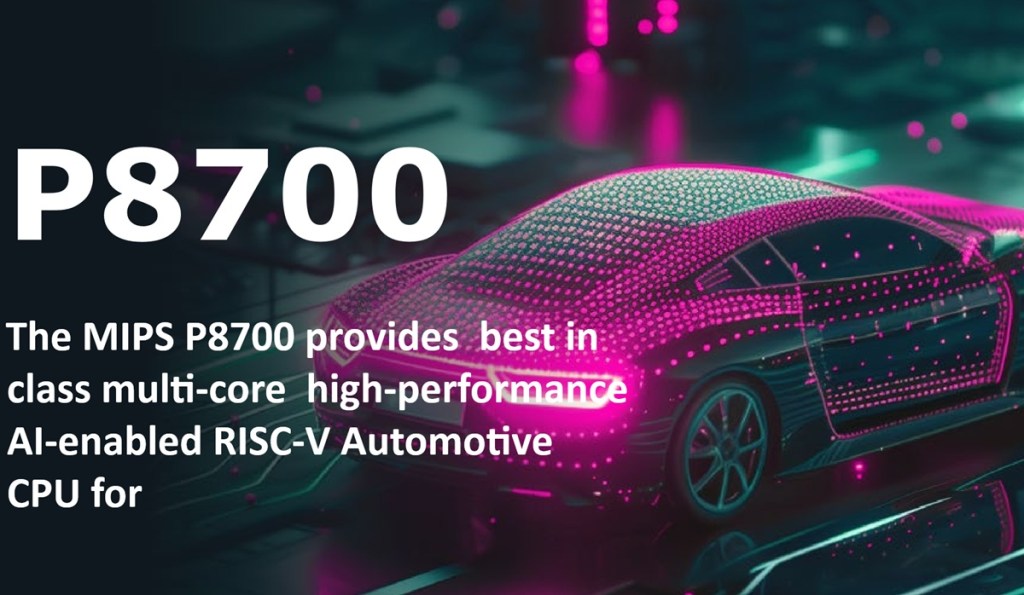Today, we’re talking about work. Specifically, where we work, how our expectations of working remotely were radically changed by the covid-19 pandemic, and how those expectations feel like they’re on the verge of changing yet again. For many people, the pendulum has swung wildly between working fully remote and now a push to return to the office from their bosses, and there are a lot of theories about what might be motivating big companies to try and bring everyone back.
Technology
MIPS releases RISC-V CPU for autonomous vehicles

Join our daily and weekly newsletters for the latest updates and exclusive content on industry-leading AI coverage. Learn More
MIPS released its P8700 CPU based on the RISC-V computing architecture to target driver assistance and autonomous vehicle applications.
The San Jose, California-based company, which focuses on developing efficient and configurable intellectual property compute, licenses its designs to other chip makers. Today, it is announcing the general availability launch of the MIPS P8700 Series RISC-V Processor.
Designed to meet the low-latency, highly intensive data movement demands of the most advanced automotive applications such as ADAS (advanced driver assistance system) and autonomous vehicles, the P8700 delivers accelerated compute, power efficiency and scalability, said Sameer Wasson, CEO of MIPS, in an interview with VentureBeat.
“Automotive is a big segment where we focus. It continues being a very exciting place. Some companies came and some disappeared,” Wasson said. “They lost interest. They came out of COVID and refilled their inventory. But what’s happening in the industry right now is very interesting. I think autonomy is now coming back to that steady growth rate.”
He added, “It is one of the biggest driving forces to continue innovating in terms of bringing better solutions. If you think about the solutions today, most of the deployments in vehicles are driven by what used to be vehicle technology. That was basic microcontrollers, simple stuff. They could open and close doors, run internal combustion engines. As autonomy grows, you’re going to see compute needs evolve toward more AI network compute. That allows you to have higher levels of autonomy.”
“We have technology and we have a play in making it much more mainstream than it has been,” he said.

Typical solutions for ADAS and autonomous driving rely on a brute-force approach of embedding a higher number of cores at higher clock rates driving synthetic, albeit unrealistic and unrealized performance.
The P8700 with its multi-threaded and power-efficient architecture allows MIPS customers to implement fewer CPU cores and much lower thermal design power (TDP) than the current market solutions, thereby allowing OEMs to develop ADAS solutions in an affordable and highly scalable manner. It also mitigates the system bottlenecks of data movement inefficiency by providing highly efficient, optimized and lower power latency sensitive solution specifically tailored for interrupt laden multi-sensor platforms.
“If you look at the RISC-V space overall, I think these spaces are ready for disruption, with a chance for new architectures coming in,” Wasson said. “Otherwise, EVs will be much more expensive than they need to be.”
For Level 2 or higher ADAS systems with AI Autonomous software stack, the MIPS P8700 can also offload core processing elements that cannot be easily quantized in deep learning and reduced by sparsity-based convolution processing functions, resulting in a greater than 30% better AI Stack software utilization and efficiency.
“The automotive market demands CPUs which can process a large amount of data from multiple sensors in real-time and feed the AI Accelerators to process in an efficient manner,” said Wasson. “The MIPS Multi-threading and other architectural hooks tailored for automotive applications, make it a compelling core for data intensive processing tasks. This will enable automotive OEMs to have high performance compute systems which consume less power and better utilize of AI Accelerators.”
The MIPS P8700 core, featuring multi-core/multi-cluster and multi-threaded CPU IP based on the RISC-V ISA, is now progressing toward series production with multiple major OEMs. Key customers like Mobileye (Nasdaq: MBLY) have embraced this approach for future products for self-driving vehicles and highly automated driving systems.
“MIPS has been a key collaborator in our success with the EyeQ™ systems-on-chip for ADAS and autonomous vehicles,” said Elchanan Rushinek, executive vice president of engineering for Mobileye, in a statement. “The launch of the MIPS P8700 RISC-V core will help drive our continued development for global automakers, enabling greater performance and excellent efficiency in cost and power usage.”
The P8700 Series is a high-performance out-of-order processor that implements the RISC-V RV64GC architecture, including new CPU and system-level features designed for performance, power, area form factors and additional proven features built on legacy MIPS micro-architecture deployed in more than 30+ car models today across the global OEM market.

Engineered to deliver industry-leading compute density, MIPS’ latest processor harnesses three key architectural features, including MIPS out-of-order multi-threading, which enables execution of multiple
instructions from multiple threads (harts) every clock cycle, providing higher utilization and CPU efficiency.
It also has coherent multi-core, multi-cluster, where the P8700 Series scales up to 6 coherent P8700 cores in a cluster with each cluster supporting direct attach accelerators.
And it has functional safety designed to meet the ASIL-B(D) functional safety standard (ISO26262) by incorporating several fault detection capabilities such as end-to-end parity protection on address and data buses, parity protection on software visible registers, fault bus for reporting faults to the system, and
more.
The MIPS P8700 processor is now available to the broader market, with key partnerships already in place. Shipments with OEM launches are expected shortly. MIPS has been around for three decades and billions of its chips have shipped to date.
In the past, Wasson said vendors were using the wrong computer architecture, which was built for entertainment and screen applications, rather than hardcore AI problems.
“What we are trying to do is go focus on building compute for ADAS and higher levels of autonomy, from the ground up,” he said.
Vasanth Waran, worldwide head of business development at MIPS, said in an interview with VentureBeat that other architectures have been pushing performance forward through brute force, adding more complexity and scaling, but not necessarily coming up with affordable designs.
“If you want to bring it to a larger market, you want autonomy to be affordable, and you want it to scale,” Waran said. “There needs to be a more pure approach, given the lack of a better word, and that’s what motivated us. The 8700 from the ground up is where you can move data seamlessly between different parts of a design. If you look at a car, you have a lot of sensors with data coming in, from cameras, radar, LiDAR, in some cases, and the inputs from these need to be processed. It needs to be pushed out to an AI accelerator system. And then that data needs to help you make a decision.”
MIPS’ designs try to offload a lot of the performance from AI accelerators, whether it’s in pre-processing or post-processing. With a general-purpose processor, new software can be supported, and such software for AI accelerators is changing all the time.
RISC-V has been building up its ecosystem in the past couple of years, and its ecosystem is now at the right size to support applications.
“The other big thing that’s happening is software defined vehicles. Our products can be used for a holistic software-defined vehicle architecture,” Waran said. “We’re focused completely on the autonomous journey.”
Wasson said his company will be at the CES 2025 event coming up in Las Vegas in January, where pitching automakers will be a big task for the company.
Source link
Technology
Black Friday deals bring the Google Nest wired indoor camera down to just $70

The Google Nest wired indoor camera as part of an early Black Friday deal. The cam is normally $100, so this represents a savings of 30 percent. This is close to a record low price, which is never a bad thing. The sale includes three colorways, including white, beige and light blue.
The second-gen wired device is designed for indoor use, thus the name, and is capable of capturing 1080p HDR video. It’s motion sensitive and uses a bit of AI trickery to discern between people, animals and vehicles. The camera also includes night vision and an hour of event recording on the device itself, which comes in handy in the case of a Wi-Fi outage.
There’s a two-way audio function, as the camera includes both a microphone and a speaker. People can boot up the affiliated Google Home app to spark up a conversation. This app also lets you instantly call up emergency services if the conversation doesn’t go as planned, though that requires a Nest Aware subscription.
This brings us to a fairly significant caveat, though this one pops up with most modern security cameras. A whole lot of stuff is locked behind that aforementioned Nest Aware paywall, . This plan gives purchasers 60 days of video history and the ability to watch live streams on smart displays and even smart TVs. Subscribers will even receive alerts when familiar faces are recognized by the camera.
Check out all of the latest Black Friday and Cyber Monday deals here.
Technology
Startup Battlefield 200: Celebrating outstanding achievements

This year, TechCrunch Disrupt 2024 showcased the incredible talent and groundbreaking ideas of our 2024 Startup Battlefield 200 cohort.
Out of thousands of applications, we selected 200 of the most promising startups, each bringing unique innovations to their respective industries. The competition culminated in an electrifying event where these startups had the opportunity to pitch and demonstrate their solutions live over three days.
From the Top 20 Finalists, TechCrunch editorial selected the top five companies who battled it out for the $100,000 equity-free prize money and the coveted Disrupt Cup. The well-deserved win went to Salva Health, with a strong runner up, Gecko Materials.
Among the Startup Battlefield 200 companies were many industry-defining companies exhibiting and pitching on the Showcase Stage; here are the standouts:
Best Showcase Stage pitch by industry group
Hardware, Robotics + IoT
Avol uses autonomous drones to deliver lab samples, speeding processing up to 11x faster at lower costs.
Health Tech + Biotech
Ovum Health merges molecular diagnostics, medicine, and behavioral science for healthier moms and babies.
Security, Privacy + Social Networking
Factiverse aids finance and media in verifying information, acting like Grammarly for fact-checking.
Fintech + Edtech
Untapped Solutions connects justice-impacted individuals with jobs and services via an AI-driven CRM.
Sustainability, Mobility + Logistics
Prosal helps business development teams at federal government contractors automate capture research to save time predicting contract opportunities using AI.
SaaS, Enterprise + Productivity – Session 1
Eticas.ai identifies black box algorithmic vulnerabilities and retrains AI-powered technology with better source data and content.
SaaS, Enterprise + Productivity – Session 2
OMADEUS is a dynamic network of self-aware AI agents to replace outdated productivity software for SMEs.
Best Booth — It’s a tie!
The Best Booth award ended in a tie.
Cloneable.ai hand-built and painted a utility pole out of Styrofoam to demonstrate their innovations in safety inspection for utility workers. Wave Therapeutics used the clever sign “In the Business of Saving Your Ass” as a nod to their tech designed to prevent bedsores.


Spirit of Disrupt Award
The Spirit of Disrupt award goes to Yasin Abbak from GroupUps, who went above and beyond to create connections and opportunities for fellow founders. The Startup Battlefield is more than a pitch competition; it’s an opportunity to build relationships with investors, potential customers, and fellow founders to support each other on their entrepreneurial journeys.
As we celebrate the achievements of this year’s winners, we are excited to see how they will shape their industries and drive innovation in the months and years to come. Congratulations to all the participants of the Startup Battlefield 200, and a special thank you to our judges and sponsors for their support in making TechCrunch Disrupt 2024 a resounding success.
Science & Environment
One solar stock to buy after Trump’s win hit the sector, analysts say
Technology
Why Amazon, Disney, and others are pushing employees back to the office

Here on Decoder, I’ve talked to lots of CEOs about the benefits of working fully remote versus hybrid or having everybody back in the office over the past several years, and I’ve heard the full spectrum of responses. Some executives are adamant that people need to be in the office, and others are equally adamant that fully remote is the way to go. We’ll play some of those answers for you as we go so you can get a sense of the enormous range of opinions here.
If you look at the surveys, it’s basically 50/50 — quite a lot of people want to work remotely, and they can be pretty loud online. But there are a lot of people, who are often quieter, who want to go back to the office for pretty good reasons. Some folks just don’t have the space to work from home, or they’re simply tired of making video calls in sweatpants all day and never really leaving the house. I know some people who really like just being able to leave work at the office when they head home for the day, and I’ve heard from a lot of younger people who are struggling to get face time with the more senior and experienced people at their companies in order to build relationships and grow their networks.
The messy middle of all this is what quite a few companies have settled on: hybrid work, which allows for a combination of in-office and remote work. This is how The Verge runs, and I quite like it — but it’s not perfect. Like so many people who work in a hybrid environment, there are days where I go into a mostly empty office and then sit on Zoom in a phone booth, and there are days when I realize I’m the only one in a meeting sitting at home because everyone else has gone into the office.
Figuring out how to make hybrid work is a long-term cultural project that we really only started in 2020. While there are some obvious benefits, it’s not clear if anyone’s really cracked it in a way that scales across different kinds of companies.
Now, some companies have decided the nuance just isn’t worth it. In September, Amazon mandated that all employees would return to an office five days a week starting in January. In the memo announcing the change, CEO Andy Jassy argued that the company had “observed that it’s easier to learn, model, practice, and strengthen our culture,” that “collaborating, brainstorming, and inventing are simpler and more effective,” and that “teams tend to be better connected to one another” when everyone is in the office.
Amazon isn’t alone in wanting employees back at their desks. Companies like Disney and Salesforce have also pushed for employees to come back to the office at least four days a week, making similar arguments. Other companies, like Apple, have been steadily pressuring workers to come back for quite some time — that beautiful new spaceship office in Cupertino wasn’t built to stay empty.
But is the return to office really about building company culture and being more creative and productive? I have to tell you, there is a huge chunk of The Verge and Decoder audience that is absolutely convinced that any big return-to-office policy change is actually just a layoff in disguise — we get emails making this case virtually every time one of these moves is announced.
Jassy even addressed this directly, just a few days ago, in an all-hands meeting. Responding to claims that the return-to-work mandate is a quote “backdoor layoff,” he told employees that that is simply not true. We’ll come back to that later on.
So I wanted to know what’s been going on, what the real reasons behind return-to-office might be, and where this is all headed next. To explain it, I caught up with two experts on the subject: Stephan Meier, a professor of business strategy at Columbia Business School, and Jessica Kriegel, the chief strategy officer at workplace culture consultancy Culture Partners.
We dive into what’s been happening to the nature of work today, and you’ll hear both of them lay out some of the key reasons behind the return-to-office push. We also try to figure out whether Amazon is just an outlier or, as you’ll hear Jessica say, “the tip of the spear” in what could be something much bigger.
Here are some of the news stories, surveys, and studies we discussed in this episode, if you’d like to learn more:
- Amazon is making its employees come back to the office five days a week | The Verge
- Amazon CEO Andy Jassy denies that 5-day office mandate is a ‘backdoor layoff’ | CNBC
- Bob Iger tells Disney employees they must return to the office four days a week | CNBC
- A quarter of bosses admit return-to-office mandates meant to make staff quit | Fortune
- More Americans now prefer hybrid over fully remote work, survey finds | Axios
- Google tells staff: stay productive and we’ll stay flexible | Business Insider
- The list of major companies requiring employees to return to the office | Business Insider
- Thinking Inside the Box: Why Virtual Meetings Generate Fewer Ideas | Columbia
- Duolingo CEO Luis von Ahn wants you addicted to learning | Decoder
- The CEO of Zoom wants AI clones in meetings | Decoder
- Sundar Pichai on managing Google through the pandemic | The Vergecast
Technology
What will power the future of digital commerce?


Today, digital commerce is a primary business driver for retailers, brands, and distributors. According to an analysis of US Census Bureau data by research firm Stratably, 2024 revenue from digital is projected to grow 8.4% in the U.S. market compared to in-store growth of 1.2%.
As digital commerce has grown in importance there has been a corresponding explosion of downstream channels where brand manufacturers must send content, from retail stores to marketplaces to social shopping and direct-to-consumer websites. Each of these channels has distinct rules for the product data they will accept and these rules change often; Target, Walmart and Amazon changed their data ingestion requirements nearly 1,000 times combined in 2023. The reasons for these changes vary: differing regional regulatory requirements, unique merchandising opportunities the channel requires, or varying rates of digital maturity between the channels.
These constant changes make it exceedingly difficult for business teams to keep their data organized and optimized for each destination. It’s equally difficult for IT teams to maintain data governance and traceability of the enterprise’s product data as its sent so frequently to so many different channels. To achieve success, many organizations use a Product Information Management (PIM) system to centralize and store product data, but the architecture of a classic stand-alone PIM solution isn’t designed to support digital commerce. In fact, it may impede success.
Product experience management (PXM) solutions, on the other hand, were built for digital commerce and are already seeing widespread adoption by brands, retailers, and distributors looking to centralize, connect, and automate the product data that powers digital, omnichannel commerce.
How do PIM and PXM solutions compare, and which is best enabled to help your team win in digital commerce?
Features of a Classic PIM
Classic PIMs were created to manage internal data against an internal data schema. IT teams define the schema’s attributes and properties across relational databases, cleanse their data, and then load that data into the PIM to create a single “golden record” for each product.
Key Classic PIM use cases include:
The “Golden Record”: The PIM category emerged when the critical need for IT leaders was to centralize disparate product information, creating a single “golden record” for each product via relational databases based on an internal data schema. However, the golden record has lost relevance as business teams must now store, manage, optimize, and deliver hundreds or even thousands of continually optimizable golden records based on external schemas and requirements. Failing to do so could result in product data never being published, lost search rank and ultimately, and lost sales.
Rigid Data Management: Classic PIMs effectively aim to prevent changes once the data has been entered into the predetermined schema, creating a rigid data management process that makes it both difficult and expensive to update data; business teams rarely have access to change any of the data or attributes in the PIM and doing so requires going through IT or a third party PIM vendor. However, with endpoints changing their requirements so frequently, a system that will enable success in commerce must actively enable, not prevent, revisions to data as business teams optimize product information for delivery to each endpoint.
The PXM Use Case
PXMs are a blend of PIM back-office data management functionality with front-office, market-facing capability. They incorporate PIM features like hierarchy, taxonomy, and governance while adding on additional major capability areas to support digital commerce, including:
Multichannel data management: Management of channel-specific data schemas, values, and validation, allowing users to store a golden record while simultaneously storing versions of the product record that meet the requirements of each data destination.
Channel connectivity: Connectivity to channel destinations, such as Amazon and Global Data Synchronization Network (GDSN), to get information to market faster, often via different mechanisms tailored to each destination.
Collaborative workflows: Workflows that typically involve people in other businesses, such as third-party agencies, distribution partners, or downstream retail customers.
Enhanced content: More types of data and attributes, including assets to support content like videos, comparison charts, and lifestyle imagery.
Enterprise-wide user access: Administrative features to enable many users to access and use the product data for their own workstreams (e.g., legal, retail media, service, and support teams).
Automation: Automation to drive cross-team collaboration; proactive alerts about content gaps and errors; AI-driven content generation and recommendations; and more.
PXM solutions were designed to be a flexible (not rigid) system of record that can store a core product record just like a PIM, while still allowing transformations of that record to meet each endpoint’s unique requirements. These key features of PXMs allow teams to collaborate to keep up with the pace of digital commerce, driving success for their organizations.
An Expansion of the PIM Category
PXM solutions were initially worse at product information management than PIM solutions but better at syndication, connecting product information to various destinations on the digital shelf to drive sales for the enterprise.
Today, PXM solutions actually provide better data management than classic PIM solutions. They’re designed to create and manage the golden record, which is the primary goal of a PIM solution, and connect this information to the digital shelf to drive enterprise sales — all while maintaining adaptability to constantly changing market requirements.
PXM solutions can do everything PIM solutions can, but PIM solutions can’t do everything PXM solutions can. This represents a fundamental expansion of the definition of the product information management category, which has created a new category altogether.
PIM for commerce will cease to exist
The product information management category is one in transition, with PXM solutions driving a fundamental expansion of the basic use case for systems that store product information.
Anyone buying a classic PIM solution for commerce will have to either replace it or add a PXM solution sooner rather than later and eventually, PIM-only software solutions will become obsolete.
On the other hand, innovation and investment in PXM is advancing rapidly. It’s an exciting space that will continue revolutionizing shopper experiences to drive significant value to the enterprise.
We’ve featured the best e-commerce platform.
This article was produced as part of TechRadarPro’s Expert Insights channel where we feature the best and brightest minds in the technology industry today. The views expressed here are those of the author and are not necessarily those of TechRadarPro or Future plc. If you are interested in contributing find out more here: https://www.techradar.com/news/submit-your-story-to-techradar-pro
Technology
Will you benefit from the Apple TV’s new 21:9 aspect ratio?

Apple this week released the latest developer beta of tvOS 18.2, the software that powers the company’s Apple TV 4K streaming media devices. As previewed during the WWDC 2024 keynote, the new software includes support for 21:9 and several other aspect ratios that are wider than 16:9, which has become the dominant shape for modern TVs.
Why does that matter?
Most of us have experienced letterboxing or pillarboxing — that’s when a set of horizontal or vertical black bars frame the content on our TVs. It happens when there’s a mismatch between the aspect ratio of a movie or show and the aspect ratio of your screen.
A lot of modern content, especially shows and movies developed for streaming services like Netflix, Max, Paramount+, or Apple TV+, is shot in 16:9, so letterboxing that content on 16:9 TVs isn’t necessary. On the Apple TV 4K, even the user interface is formatted for this ratio, which keeps things looking good.
However, some folks own projector screens or widescreen monitors with non-16:9 aspect ratios. For these people, all Apple TV 4K content ends up with those pesky black bars because the device’s signal is formatted for 16:9. When tvOS 18.2 arrives for everyone in December, the software should automatically detect the ratio of your display, and reformat itself to match.

If that detection fails, a new Aspect Ratio settings menu will let you manually select the appropriate one for your setup. Available ratios are 16:9, 21:9, 2.37:1, 2.39:1, 2.40:1, DCI 4K, and 32:9.
It will be the first time that someone who owns a 21:9 projector, or who uses an anamorphic lens to achieve a ratio like 2.39:1, can get the Apple TV 4K to produce a perfectly proportioned and fullscreen image.
So how many people will benefit from the new settings? “It really won’t affect very many,” said Jeff Gosselin, chief experience officer at Cloud 9 AV, a Toronto-based custom home theater installer. “Any new theaters we have done in the past 15 years have all used 16:9 screens. For any ultrawide projection systems, this will be an enhanced viewing experience.”
Pillarboxing will still likely occur when watching 16:9 content on such a screen, but when 21:9 content is available, it should play in fullscreen, with no black bars.
Presumably, app developers — like the services mentioned above — will have to update their apps to ensure that their content displays correctly under the new aspect ratio settings. But eventually, this will become the norm.
-

 Science & Environment2 months ago
Science & Environment2 months agoHow to unsnarl a tangle of threads, according to physics
-

 Technology1 month ago
Technology1 month agoIs sharing your smartphone PIN part of a healthy relationship?
-

 Science & Environment2 months ago
Science & Environment2 months agoHyperelastic gel is one of the stretchiest materials known to science
-

 Science & Environment2 months ago
Science & Environment2 months ago‘Running of the bulls’ festival crowds move like charged particles
-

 Technology2 months ago
Technology2 months agoWould-be reality TV contestants ‘not looking real’
-

 Science & Environment1 month ago
Science & Environment1 month agoX-rays reveal half-billion-year-old insect ancestor
-

 Science & Environment2 months ago
Science & Environment2 months agoPhysicists have worked out how to melt any material
-

 Science & Environment2 months ago
Science & Environment2 months agoMaxwell’s demon charges quantum batteries inside of a quantum computer
-

 Money1 month ago
Money1 month agoWetherspoons issues update on closures – see the full list of five still at risk and 26 gone for good
-

 Sport1 month ago
Sport1 month agoAaron Ramsdale: Southampton goalkeeper left Arsenal for more game time
-

 MMA1 month ago
MMA1 month ago‘Dirt decision’: Conor McGregor, pros react to Jose Aldo’s razor-thin loss at UFC 307
-

 Science & Environment2 months ago
Science & Environment2 months agoSunlight-trapping device can generate temperatures over 1000°C
-

 Football1 month ago
Football1 month agoRangers & Celtic ready for first SWPL derby showdown
-

 News1 month ago
News1 month agoWoman who died of cancer ‘was misdiagnosed on phone call with GP’
-

 Science & Environment2 months ago
Science & Environment2 months agoLaser helps turn an electron into a coil of mass and charge
-

 Technology1 month ago
Technology1 month agoUkraine is using AI to manage the removal of Russian landmines
-
Business1 month ago
how UniCredit built its Commerzbank stake
-

 Technology1 month ago
Technology1 month agoGmail gets redesigned summary cards with more data & features
-

 News1 month ago
News1 month ago‘Blacks for Trump’ and Pennsylvania progressives play for undecided voters
-

 Technology1 month ago
Technology1 month agoSamsung Passkeys will work with Samsung’s smart home devices
-

 Sport1 month ago
Sport1 month agoBoxing: World champion Nick Ball set for Liverpool homecoming against Ronny Rios
-

 Science & Environment2 months ago
Science & Environment2 months agoA new kind of experiment at the Large Hadron Collider could unravel quantum reality
-

 Science & Environment2 months ago
Science & Environment2 months agoLiquid crystals could improve quantum communication devices
-

 Technology1 month ago
Technology1 month agoRussia is building ground-based kamikaze robots out of old hoverboards
-

 Technology1 month ago
Technology1 month agoEpic Games CEO Tim Sweeney renews blast at ‘gatekeeper’ platform owners
-

 Science & Environment2 months ago
Science & Environment2 months agoWhy this is a golden age for life to thrive across the universe
-

 Science & Environment2 months ago
Science & Environment2 months agoQuantum ‘supersolid’ matter stirred using magnets
-

 MMA1 month ago
MMA1 month agoDana White’s Contender Series 74 recap, analysis, winner grades
-

 News1 month ago
News1 month agoNavigating the News Void: Opportunities for Revitalization
-

 Sport1 month ago
Sport1 month ago2024 ICC Women’s T20 World Cup: Pakistan beat Sri Lanka
-

 News1 month ago
News1 month agoMassive blasts in Beirut after renewed Israeli air strikes
-

 Entertainment1 month ago
Entertainment1 month agoBruce Springsteen endorses Harris, calls Trump “most dangerous candidate for president in my lifetime”
-

 Technology1 month ago
Technology1 month agoMicrosoft just dropped Drasi, and it could change how we handle big data
-

 MMA1 month ago
MMA1 month ago‘Uncrowned queen’ Kayla Harrison tastes blood, wants UFC title run
-

 MMA1 month ago
MMA1 month agoPereira vs. Rountree prediction: Champ chases legend status
-

 Technology1 month ago
Technology1 month agoMicrophone made of atom-thick graphene could be used in smartphones
-

 Technology1 month ago
Technology1 month agoCheck, Remote, and Gusto discuss the future of work at Disrupt 2024
-

 News1 month ago
News1 month agoRwanda restricts funeral sizes following outbreak
-

 Sport1 month ago
Sport1 month agoWXV1: Canada 21-8 Ireland – Hosts make it two wins from two
-
Business1 month ago
Top shale boss says US ‘unusually vulnerable’ to Middle East oil shock
-

 TV1 month ago
TV1 month agoসারাদেশে দিনব্যাপী বৃষ্টির পূর্বাভাস; সমুদ্রবন্দরে ৩ নম্বর সংকেত | Weather Today | Jamuna TV
-

 Business1 month ago
Business1 month agoWater companies ‘failing to address customers’ concerns’
-

 Technology1 month ago
Technology1 month agoWhy Machines Learn: A clever primer makes sense of what makes AI possible
-

 Science & Environment2 months ago
Science & Environment2 months agoQuantum forces used to automatically assemble tiny device
-

 News2 months ago
News2 months ago▶️ Hamas in the West Bank: Rising Support and Deadly Attacks You Might Not Know About
-

 News1 month ago
News1 month agoCornell is about to deport a student over Palestine activism
-

 Technology1 month ago
Technology1 month agoSingleStore’s BryteFlow acquisition targets data integration
-

 Business1 month ago
Business1 month agoWhen to tip and when not to tip
-

 News1 month ago
News1 month agoHull KR 10-8 Warrington Wolves – Robins reach first Super League Grand Final
-

 MMA1 month ago
MMA1 month agoKayla Harrison gets involved in nasty war of words with Julianna Pena and Ketlen Vieira
-

 Science & Environment2 months ago
Science & Environment2 months agoITER: Is the world’s biggest fusion experiment dead after new delay to 2035?
-

 Technology2 months ago
Technology2 months agoMeta has a major opportunity to win the AI hardware race
-

 Science & Environment2 months ago
Science & Environment2 months agoA slight curve helps rocks make the biggest splash
-

 Science & Environment2 months ago
Science & Environment2 months agoNuclear fusion experiment overcomes two key operating hurdles
-

 Football1 month ago
Football1 month ago'Rangers outclassed and outplayed as Hearts stop rot'
-

 MMA1 month ago
MMA1 month agoPennington vs. Peña pick: Can ex-champ recapture title?
-

 Technology1 month ago
Technology1 month agoLG C4 OLED smart TVs hit record-low prices ahead of Prime Day
-
Travel1 month ago
World of Hyatt welcomes iconic lifestyle brand in latest partnership
-

 News1 month ago
News1 month ago▶ Hamas Spent $1B on Tunnels Instead of Investing in a Future for Gaza’s People
-

 Sport1 month ago
Sport1 month agoShanghai Masters: Jannik Sinner and Carlos Alcaraz win openers
-

 Sport1 month ago
Sport1 month agoChina Open: Carlos Alcaraz recovers to beat Jannik Sinner in dramatic final
-

 Football1 month ago
Football1 month agoWhy does Prince William support Aston Villa?
-

 Sport1 month ago
Sport1 month agoPremiership Women’s Rugby: Exeter Chiefs boss unhappy with WXV clash
-

 Money4 weeks ago
Money4 weeks agoTiny clue on edge of £1 coin that makes it worth 2500 times its face value – do you have one lurking in your change?
-

 Technology1 month ago
Technology1 month agoUniversity examiners fail to spot ChatGPT answers in real-world test
-

 Womens Workouts1 month ago
Womens Workouts1 month ago3 Day Full Body Women’s Dumbbell Only Workout
-

 Technology1 month ago
Technology1 month agoMusk faces SEC questions over X takeover
-

 Sport1 month ago
Sport1 month agoSturm Graz: How Austrians ended Red Bull’s title dominance
-

 Sport1 month ago
Sport1 month agoCoco Gauff stages superb comeback to reach China Open final
-
Business1 month ago
Bank of England warns of ‘future stress’ from hedge fund bets against US Treasuries
-

 MMA1 month ago
MMA1 month ago‘I was fighting on automatic pilot’ at UFC 306
-

 Science & Environment2 months ago
Science & Environment2 months agoNerve fibres in the brain could generate quantum entanglement
-

 Science & Environment2 months ago
Science & Environment2 months agoTime travel sci-fi novel is a rip-roaringly good thought experiment
-

 TV1 month ago
TV1 month agoTV Patrol Express September 26, 2024
-

 News1 month ago
News1 month agoGerman Car Company Declares Bankruptcy – 200 Employees Lose Their Jobs
-

 Sport1 month ago
Sport1 month agoURC: Munster 23-0 Ospreys – hosts enjoy second win of season
-

 Sport1 month ago
Sport1 month agoWales fall to second loss of WXV against Italy
-

 MMA1 month ago
MMA1 month agoHow to watch Salt Lake City title fights, lineup, odds, more
-
Business1 month ago
DoJ accuses Donald Trump of ‘private criminal effort’ to overturn 2020 election
-
Business1 month ago
Sterling slides after Bailey says BoE could be ‘a bit more aggressive’ on rates
-
Business1 month ago
Italy seeks to raise more windfall taxes from companies
-
Business1 month ago
‘Let’s be more normal’ — and rival Tory strategies
-

 Sport1 month ago
Sport1 month agoNew Zealand v England in WXV: Black Ferns not ‘invincible’ before game
-

 News2 months ago
News2 months ago▶️ Media Bias: How They Spin Attack on Hezbollah and Ignore the Reality
-

 Science & Environment2 months ago
Science & Environment2 months agoHow to wrap your mind around the real multiverse
-

 Technology1 month ago
Technology1 month agoJ.B. Hunt and UP.Labs launch venture lab to build logistics startups
-

 Technology1 month ago
Technology1 month agoAmazon’s Ring just doubled the price of its alarm monitoring service for grandfathered customers
-

 Technology1 month ago
Technology1 month agoQuoroom acquires Investory to scale up its capital-raising platform for startups
-
Business1 month ago
The search for Japan’s ‘lost’ art
-

 MMA1 month ago
MMA1 month agoKetlen Vieira vs. Kayla Harrison pick, start time, odds: UFC 307
-

 Technology1 month ago
Technology1 month agoThe best shows on Max (formerly HBO Max) right now
-

 Technology1 month ago
Technology1 month agoIf you’ve ever considered smart glasses, this Amazon deal is for you
-

 MMA1 month ago
MMA1 month agoKevin Holland suffers injury vs. Roman Dolidze
-

 News1 month ago
News1 month agoTrump returns to Pennsylvania for rally at site of assassination attempt
-

 Sport1 month ago
Sport1 month agoMan City ask for Premier League season to be DELAYED as Pep Guardiola escalates fixture pile-up row
-

 MMA1 month ago
MMA1 month agoUFC 307’s Ketlen Vieira says Kayla Harrison ‘has not proven herself’
-

 News1 month ago
News1 month agoHarry vs Sun publisher: ‘Two obdurate but well-resourced armies’
-
Politics1 month ago
‘The night of the living dead’: denial-fuelled Tory conference ends without direction | Conservative conference
-

 Technology4 weeks ago
Technology4 weeks agoNintendo’s latest hardware is not the Switch 2
-

 Technology4 weeks ago
Technology4 weeks agoThe FBI secretly created an Ethereum token to investigate crypto fraud



You must be logged in to post a comment Login